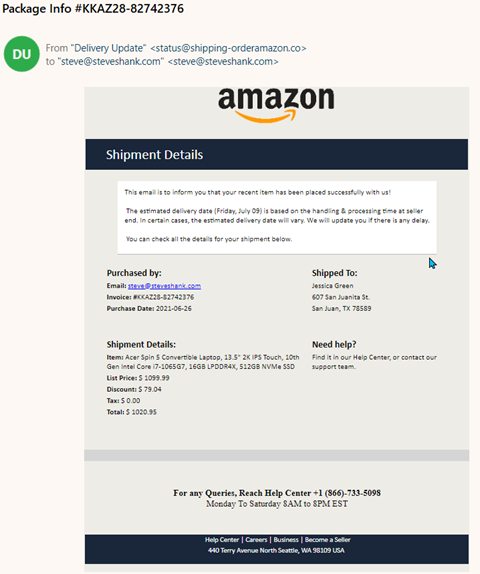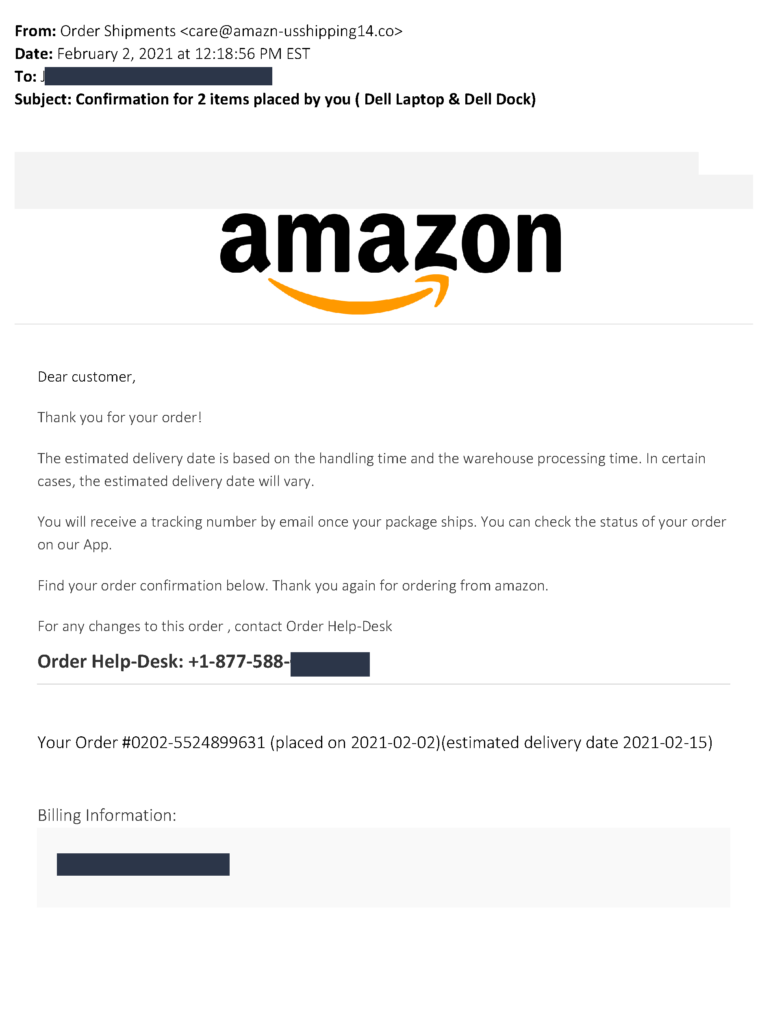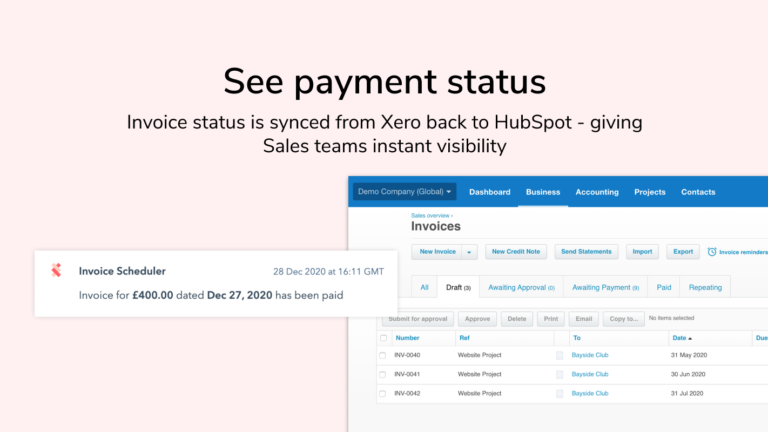Amazon.com

Order Confirmation

Order Number: 111-2222222-3333333
Order Date: 2024-02-28
Shipping Address
John Doe
123 Main Street
Anytown, CA 12345
United States
Billing Address
John Doe
123 Main Street
Anytown, CA 12345
United States
Payment Method
Visa ending in 1234
Exp. Date: 02/25
Items Ordered
| Item | Quantity | Price | Total |
|---|---|---|---|
| Apple iPhone 14 Pro Max, 128GB, Silver | 1 | $999.00 | $999.00 |
| Apple Watch Series 8, GPS, 41mm, Silver | 1 | $399.00 | $399.00 |
| AirPods Pro (2nd Generation) | 1 | $249.00 | $249.00 |
| Total | $1,647.00 |
Shipping
Standard Shipping
Estimated Delivery: March 10-15, 2024
Contact Us
If you have any questions or need assistance, please contact our Customer Service at:
- Phone: 1-800-282-1981
- Email: [email protected]
Thank you for your order!## [Fake Amazon Order Receipt]
Executive Summary
This article exposes the deceptive tactics employed by scammers to create fake Amazon order receipts as part of sophisticated phishing schemes. It provides a comprehensive guide to identify, report, and protect against these fraudulent attempts, empowering individuals to safeguard their personal information and financial well-being.
Introduction
With the increasing prevalence of online shopping, it is crucial to be vigilant against cyber threats. One common scam involves the circulation of fake Amazon order receipts, designed to trick unsuspecting victims into disclosing sensitive data or making fraudulent payments. This article delves into the inner workings of these deceptive receipts, providing valuable knowledge and practical tips for consumers to combat this growing issue.
FAQs
- How do I identify a fake Amazon order receipt?
- Check the sender’s email address for suspicious characters or misspellings.
- Examine the receipt for grammatical errors or inconsistencies in formatting.
- Note any unusual or inesperado items listed in the order.
- What should I do if I receive a fake Amazon order receipt?
- Do not click on any links or open any attachments within the receipt.
- Forward the email to reportphishing@amazon.com to alert Amazon’s security team.
- Contact your bank or credit card company immediately to report any unauthorized transactions.
- How can I protect myself from fake Amazon order receipts?
- Enable two-factor authentication on your Amazon account.
- Be cautious of unsolicited emails, especially those requesting personal information.
- Regularly monitor your Amazon account for suspicious activity.
Subtopics and Explanations
1. Phishing Scams
Phishing is a fraudulent technique where scammers attempt to obtain sensitive information by disguising themselves as legitimate organizations. Fake Amazon order receipts are a common phishing tactic, designed to trick victims into providing their login credentials, credit card numbers, or other personal data.
- Important Considerations:
- Phishing emails often create a sense of urgency or fear to pressure victims into quick action.
- Scammers may include links that redirect to malicious websites that mimic the Amazon login page.
- Victims who provide their information on these fake websites risk having their accounts compromised or financial assets stolen.
2. Email Spoofing
Email spoofing is a technique used by scammers to forge the sender’s email address, making it appear as if the email came from a legitimate source such as Amazon. This tactic enhances the credibility of the fake order receipt and increases the likelihood of victims falling prey to the scam.
- Important Considerations:
- Scammers use sophisticated techniques to spoof email addresses, making it difficult to distinguish between genuine and fake emails.
- Hovering over the sender’s email address or checking the email headers can reveal the true origin of the message.
- Be wary of emails with poor grammar or spelling, as these are common indicators of spoofing attempts.
3. Legitimate-Looking Receipts
Scammers create fake order receipts that closely resemble genuine Amazon receipts, complete with familiar logos, formatting, and order details. This attention to detail makes it challenging for victims to identify the deception.
- Important Considerations:
- Carefully examine the receipt for any inconsistencies, such as missing or incorrect order numbers or unexpected items.
- Check the Amazon website or app directly to verify the existence of the order.
- Trust your instincts; if something about the receipt feels suspicious, it is best to proceed with caution.
4. Payment Request Scams
Some fake Amazon order receipts include a request for payment, either through a link to a fake payment page or by providing bank account information. Scammers use this tactic to trick victims into making fraudulent payments.
- Important Considerations:
- Amazon never requests payment via email or text message.
- If you receive an email requesting payment, do not click on any links or provide any financial information.
- Report the email to Amazon and your bank immediately.
5. Malicious Attachments
Fake Amazon order receipts may contain attachments that appear to be invoices or shipping confirmations. These attachments often contain malware or viruses that can infect your computer or mobile device.
- Important Considerations:
- Never open attachments from unknown senders, even if they appear to be legitimate.
- Use updated antivirus and anti-malware software to protect your devices from malicious code.
- If you accidentally open an attachment and suspect infection, disconnect your device from the internet and contact a cybersecurity professional.
Conclusion
Fake Amazon order receipts are a sophisticated and evolving threat that can jeopardize your personal information and financial security. By understanding the tactics used by scammers, you can effectively identify and protect yourself from these deceptive attempts. Remember to remain vigilant, report suspicious emails to Amazon, and contact your bank or credit card company if you believe you have been targeted by a scam. By working together, we can combat these malicious activities and safeguard our online safety.
Keyword Tags
- Phishing Scams
- Email Spoofing
- Fake Amazon Order Receipts
- Online Fraud
- Cybersecurity

